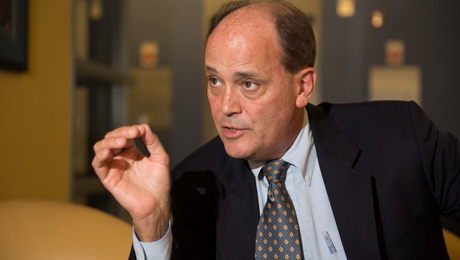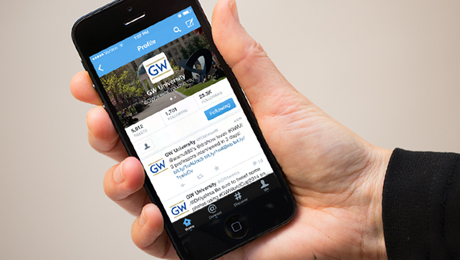By James Irwin
A few years ago, the management of a company’s Facebook page often was an additional responsibility added to the workload of an employee or dumped on an intern.
Those days are long gone. Postings for social professionals on LinkedIn grew 1,357 percent from 2010 to 2013. Last fall, a University of Massachusetts Dartmouth study reported 77 percent of Fortune 500 companies are on Twitter. The evolution of advanced metrics, from Facebook insights to Twitter analytics, has given rise to an entire industry of public relations professionals who use social media as a primary communications channel.
The emergence of a strategic side of social media has driven behavioral change in organizations, said Larry Parnell, strategic public relations program director and associate professor in the Graduate School of Political Management. His new class, “Social Media 2.0: Advanced Strategies for PR/PA Professionals,” aims to provide training and analysis of social strategy for GSPM students.
“Social media is driving an elevation of public relations as part of the marketing mix of organizations,” he said. “Two years ago the title ‘social media manager’ didn’t exist; now it’s something companies are specifically looking for. They understand there are conversations going on out there, and if you’re not listening and participating you may be missing out or blindsided by a problem.”
*
Social strategy, much like ethics, has existed as a topic within GSPM courses for years, Mr. Parnell said. Like the rise of social media professionals, market demand sparked his decision to create a dedicated course on the topic. The class, which meets weekly at the Graduate Education Center in Alexandria, has—like all GSPM courses—a focus on practical, applied learning. Four of the 10 sessions are devoted to workshop-like presentations he calls “deep dives.” They are led by a guest speaker working in strategic social media.
 A shift in the market led Larry Parnell to offer a course in advanced strategies in social media. "I was reluctant at first to devote a dedicated course to a tool," he said. "But there are strategic considerations about which platform to use, what frequency and what kind of outreach. I'm looking to put social media into the context of strategic public relations."
A shift in the market led Larry Parnell to offer a course in advanced strategies in social media. "I was reluctant at first to devote a dedicated course to a tool," he said. "But there are strategic considerations about which platform to use, what frequency and what kind of outreach. I'm looking to put social media into the context of strategic public relations."
Last week’s speaker, Danielle Brigida, senior manager of social strategy and integration for the National Wildlife Federation, covered a range of topics, including crowdfunding, curating audience-produced content and best practices for how organizations can build communities through social channels.
Increasing traffic to a website isn’t necessarily the most accurate measurement of success, she said.
“At first, I was doing so much work around driving traffic, because that was the way you could see results,” she said. “If I hit the Digg front page we would get 60,000 pageviews in a few minutes, and we’d get maybe six donations. What I realized was I wanted so much more than traffic; I wanted meaningful interaction.”
Ms. Brigida’s lecture covered the first half of the class. During the second, students broke into groups and audited four nonprofit organizations, analyzing how they use social media, from tone of voice and frequency of posts to brand consistency and customer service.
“We’ve had the opportunity to compare and contrast platforms,” said Jessica Fontaine, a graduate student in the strategic public relations program. “We are seeing which platforms work best for certain industries—nonprofit, for-profit, agency, politics—or in certain situations. Crisis management, for example, is a situation where social networks have become huge because they are interactive and immediate.”
*
Twitter, Ms. Fontaine said, has emerged as perhaps the most widely used social tool in crisis situations. Nonprofit organizations that work in natural disaster preparation and relief use the 140-character platform to alert followers of incoming weather systems and communicate shelter locations. They also use it to make decisions as they deploy volunteers.
PHOTO: Our disaster lead delivers a blanket to a resident after a fire at Fox Rest Apts in Henrico @HenricoCitizen pic.twitter.com/9CD0BvnyuU
— RedCrossRichmondVA (@RedCrossRVA) May 24, 2014
The American Red Cross, Mr. Parnell said, uses social media well in developing situations. "They take photos of workers and volunteers responding to a crisis. It’s an example of using social media to communicate, very quickly, that something is happening and the organization is doing something. You can put out all the press releases in the world that says you are doing that but a picture adds a human element to the story. There’s no question the Red Cross is responding."
“If you send a tweet saying you have a loved one stuck in a high-rise in an affected area, then the Red Cross could send someone there to help,” Mr. Parnell said. “By monitoring Twitter and using hashtags, organizations know where to go with their limited number of assets in a responsive timeframe. It’s become a valuable resource in an emergency.”
Twitter isn’t alone. Instagram has emerged as an effective crisis tool, using visuals to show, rather than say, what organizations do during emergencies. For public affairs professionals, social media’s emergence as a primary medium has meant a shift toward access—demonstrating action to the general public and creating a hybrid form of public relations where traditional and new media are used to pitch content to the press.
Instagram, Mr. Parnell said, has evolved out of the celebrity culture into a useful public relations tool. "When Beyonce and Jay Z and the sister had the fight in the elevator, the way they responded was by posting photos on Instagram—almost saying ‘everything's cool.’"
Instead of emailing reporters with story ideas, Mr. Parnell said, media relations professionals now send them succinct, targeted tweets. Instead of faxing press releases to news organizations, companies self-publish reports and use social networks to push content all over the Web.
“If you think about the evolution of public relations, going from phone calls to faxes to email, all the way to today, the extent to which social media is changing the way this business works is almost unprecedented,” Mr. Parnell said.
But social media, he and Ms. Brigida stressed, is not the end of traditional public relations; it’s another tool for professionals to use. The most effective social strategists adhere to a longstanding ethos in which authenticity remains the most valuable currency. Twitter may change the way the public relations game is played, but it doesn’t remove all the rules.
“The one thing I don’t want to do is take away authentic conversation by being present in the room,” Ms. Brigida said. “The more I can blend my online and offline brand the better. The best organizations use social media to achieve their mission more effectively—that’s the sweet spot.”


